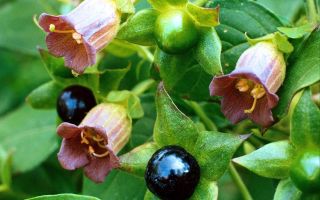Content
- 1 What does the belladonna look like and where does it grow
- 2 Chemical composition
- 3 Medicinal properties of belladonna ordinary
- 4 What Belladonna helps with
- 5 Belladonna during pregnancy and lactation
- 6 The use of belladonna ordinary in folk medicine
- 7 Is it possible to get poisoned by belladonna
- 8 Contraindications to the use of belladonna
- 9 Collecting and harvesting belladonna
- 10 Conclusion
- 11 Reviews on the use of belladonna
The medicinal properties of belladonna have been used in alternative medicine for over 1000 years. Its demand is due to the content of the alkaloid atropine, which has a lot of useful properties. But at the same time, belladonna is considered a poisonous plant, which, under certain circumstances, can lead to death.
What does the belladonna look like and where does it grow
Belladonna is a perennial herb belonging to the Solanaceae family. It is also called belladonna and wolfberry. In ancient times, the plant was used for the preparation of cosmetics, and today it is successfully used in medicine. In Italy, belladonna juice was instilled into the eyes to dilate the pupils. This made the look more attractive.
Belladonna has a purple or green stem that forks at the top. It can reach a height of 90 cm. The rhizome, from the middle of which the shoots extend, has the shape of a cylinder. Belladonna leaves are ovoid, with sharp edges. They are larger at the bottom than at the top. The flowering period is June-August. Belladonna flowers are bell-shaped and greenish-brown. The fruits are shiny round black or green berries. From a distance they resemble olives.
Belladonna lives in European countries, the Caucasus, North Africa, Asia Minor and Western Ukraine. On the territory of Russia, it is found in the Crimea. Belladonna prefers a humid mild climate with snowy winters and cool summers. Fertile forest soil is most suitable for her.
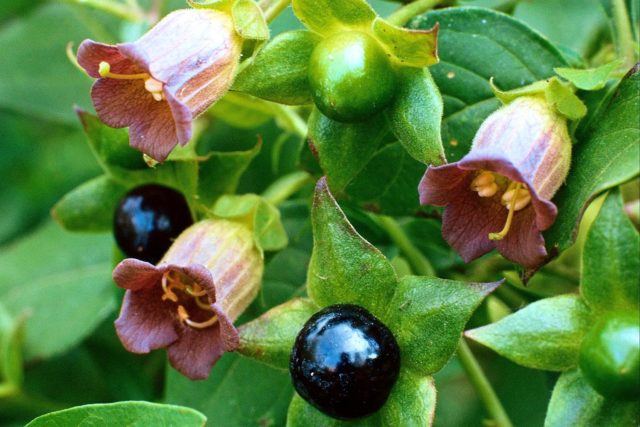
Chemical composition
The benefits and harms of belladonna are due to its rich chemical composition. It contains alkaloids with high biological activity. When used in small doses, they produce a therapeutic effect, and in large doses they have a toxic effect on the body. The chemical composition of belladonna ordinary contains the following substances:
- steroids;
- kaempferol;
- phenolic acids;
- aliphatic alcohols;
- organic acids;
- wax;
- alkaloids;
- flavonoids;
- oxycoumarins;
- minerals;
- slime.
Medicinal properties of belladonna ordinary
Belladonna was not just used in alternative medicine. It has a whole range of useful properties. First of all, the substances in its composition tone the body, activating physical and mental activity. As a result, the performance and endurance of a person increases. At the same time, belladonna copes with a number of serious diseases.It can be used both as a stand-alone remedy and in addition to the main drug therapy. Medicinal properties of belladonna extract:
- antispasmodic effect;
- antiseptic effect;
- improved cardiac conduction;
- anticholinergic action;
- hemorrhoid treatment;
- neurogenic effect;
- stimulation of respiratory function;
- anti-inflammatory effect.
What Belladonna helps with
Due to a number of medicinal properties, belladonna is considered a multifunctional remedy. It is often added to the composition of effective homeopathic medicines. The main advantage of belladonna is considered to be of natural origin, which ensures the low cost of the medicine. Belladonna treats the following diseases:
- disruption of the gastrointestinal tract;
- endocrine diseases;
- pathology of the respiratory system;
- neurological problems;
- gynecological diseases;
- heart disorders;
- hemorrhoids;
- joint pain;
- diseases of the urinary system.
Belladonna during pregnancy and lactation
The possibility of using belladonna during the period of childbearing is determined with an individual consultation with a doctor. It is allowed only if the medicinal properties outweigh the potential harm. During breastfeeding, belladonna is categorically contraindicated as it poses a danger to the baby.
The use of belladonna ordinary in folk medicine
There are several ways to use belladonna for medicinal purposes. Each of them has certain nuances. Pharmaceutical companies offer a variety of products containing belladonna. But home remedies have no less effective medicinal properties.
For the treatment of hemorrhoids and diseases of the genitourinary system, belladonna candles are more suitable. Diseases of the gastrointestinal tract and endocrine diseases are eliminated by taking a decoction of belladonna. Joint pain is treated with an ointment. For neurological diseases, the intake of an alcoholic tincture of belladonna is indicated. Belladonna powder is more suitable for the treatment of bronchitis and asthma.
Belladonna ointment
Treatment of hemorrhoids with belladonna is carried out with the help of an ointment. In addition to the main component, it contains shark liver and propolis. The remedy stops bleeding and relieves pain. In addition, the ointment has a decongestant effect, preventing an increase in the size of the node.
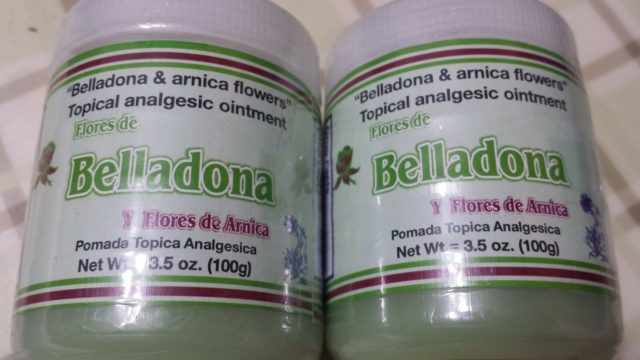
Belladonna tincture
Components:
- 200 ml of vodka;
- 2 tbsp. l. belladonna leaves.
Cooking algorithm:
- The leaves are placed in a dark glass container and filled with vodka.
- Within a week, the medicine is insisted, hiding it from exposure to sunlight.
- After the specified time, filter the tincture and take 10 drops each, diluted with water.
The healing properties of belladonna tincture include the elimination of pain. In addition, it copes well with diarrhea and flatulence. To neutralize bitterness, add 1 tsp to the tincture. honey.
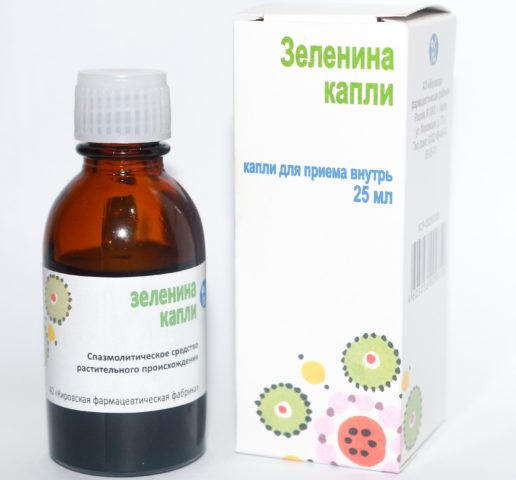
For the therapy to be effective, it is necessary to follow the algorithm for preparing the therapeutic agent. It is equally important to consider the recommended dosage regimen. With an overdose of belladonna, you can face pronounced side effects.
Infusion of belladonna
Belladonna infusion helps to normalize blood pressure and get rid of diseases of the cardiovascular system. The required effect is achieved by expanding the vascular cavity. In some cases, the remedy is used to relieve pain in the sternum.
Ingredients:
- 300 ml of water;
- 10 grams of belladonna leaves.
Cooking process:
- Belladonna leaves are placed in a deep container and filled with hot water.
- The container is closed with a lid and left for 2 hours.
- After insisting, the drink is filtered. You need to take it for 1 tsp. before going to bed. The dosage should be increased daily by ½ tsp, but you should not take more than 1 tbsp. l. medicines.
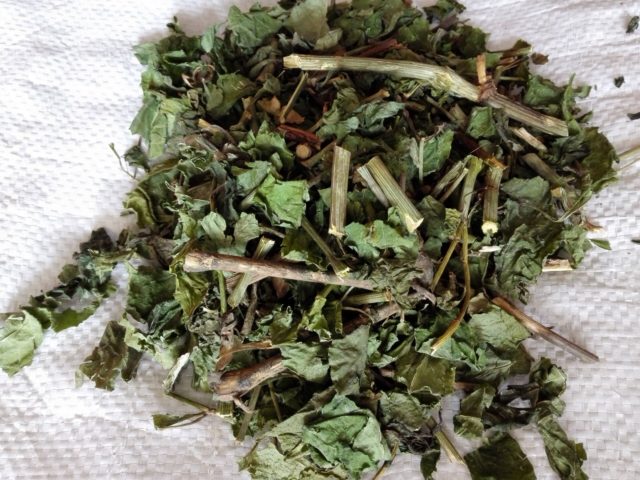
Belladonna powder
The powder is made by carefully grinding belladonna leaves. For this purpose, you can use a blender. A single dose of powder should fit on the tip of the knife. The remedy is taken 3 times a day for a week. In case of diseases of the respiratory system, it is recommended to practice inhaling the smoke from the ignited powder.

Belladonna decoction
Components:
- 5 g belladonna leaves;
- 0.1 g of activated carbon;
- 100 ml of wine.
Recipe:
- The components are placed in a small saucepan, after which it is put on fire.
- The drug is boiled for 2 hours. After removing from heat, it is insisted for 2 hours.
- Strain the broth before use. Reception is carried out in 1 tsp. in a day.

Is it possible to get poisoned by belladonna
Belladonna is not only beneficial but also harmful to health. This is due to the content of toxic substances in it. The danger is carried by the substance atropine. Getting into the body in large quantities, it is able to provoke the strongest poisoning. Therefore, when working with belladonna, protective measures should be taken - wear disposable gloves and use a mask.
Poisoning symptoms
Poisoning symptoms appear about 20 minutes after eating belladonna. The first unpleasant bells include dry mouth and dilated pupils. In the future, the following symptoms appear:
- skin rashes;
- disruption of the urinary system;
- hallucinations;
- general weakness;
- vomiting;
- dizziness.
If the poison of belladonna has entered the body in large quantities, the person is disoriented in space. Together with this, the body temperature rises, and the pulse weakens. In some cases, loss of consciousness is possible. With this condition, the risk of death increases.
First aid for poisoning with belladonna
In case of an overdose of belladonna, it is very important to provide timely assistance. First of all, you should contact specialists. Before their arrival, it is required to provoke vomiting to cleanse the gastrointestinal tract of poison. Drink plenty of fluids as well. Activated carbon has excellent adsorbing properties. 20 tablets are crushed to a powder and diluted with plenty of water. The resulting drink is taken as much as possible. If vomiting occurs, the procedure is repeated.
Heart drops should be taken if you have heart palpitations and shortness of breath. Respiratory arrest is a serious reason for the implementation of the necessary resuscitation actions. In severe cases, the patient is admitted to a hospital for further treatment.
Contraindications to the use of belladonna
In the instructions for the use of belladonna, you can see a list of contraindications. It is imperative that you familiarize yourself with it before using the remedy. Contraindications for belladonna include:
- hypertrophy of the prostate;
- glaucoma;
- pregnancy and lactation;
- tachycardia;
- coronary heart disease;
- obstructive bowel and urinary tract diseases.
Collecting and harvesting belladonna
Belladonna is usually harvested during the flowering period. Only the lower leaves need to be plucked.Wear gloves first. It is important to dry it as soon as possible after harvest.
Belladonna leaves are laid out on a straight surface in a dark, ventilated area. An attic is ideal for these purposes. Raw materials should not be exposed to direct sunlight. Dried leaves are recommended to be stored in large bags. The shelf life of the harvested raw materials is 2 years.
Conclusion
The medicinal properties of belladonna are associated with a high risk of toxic poisoning. A unique plant should be handled as carefully as possible. Neglect of the rules of use can cause irreparable harm to health.

